CH 8 Psychology
1/145
Earn XP
Description and Tags
Psychology 101
Name | Mastery | Learn | Test | Matching | Spaced |
|---|
No study sessions yet.
146 Terms
Memory
Set of processes used to encode, store, and retrieve information over different periods of time

Encoding
Gets information into our brains
Input of information into the memory system
Once we receive sensory information from the environment, our brains label or code it
What are the two processing that encoding information occurs in?
Automatic processing
Effortful processing
Automatic processing
Encoding of details like time, space, frequency, and the meaning of words
Done without any conscious awareness
Effortful processing
Required a lot of work and attention on your part in order to encode that information
What are the three types of encoding?
Semantic encoding
Visual encoding
Acoustic encoding
Semantic encoding
Encoding of words and their meaning
First demonstrated by William Bousfield (1935)
An experiment in which he asked people to memorize words
60 words were actually divided into 4 categories of meaning, although the participants did not know this because the words were randomly presented
When they were asked to remember the words, they tended to recall them in categories, showing that they paid attention to the meanings of the words as they learned them
Visual encoding
Encoding of images
Acoustic encoding
Encoding of sounds, words in particular
Psychologists Fergus Craik and Endel Tulving (1975)
Which of the three types of encoding do you think would give you the best memory of verbal information?
Words that had been encoded semantically were better remembered than those encoded visually or acoustically
Semantic encoding involves a deeper level of processing than the shallower visual or acoustic encoding
Self-reference effect
Tendency for an individual to have better memory for information that relates to oneself in comparison to material that has less personal relevance
Storage
Creation of a permanent record of information
In order for a memory to go into storage (i.e., long-term memory), it has to pass through three distinct stages
First proposed by Richard Atkinson and Richard Shiffrin (1968)
Atkinson and Shiffrin's model (picture)
Baddeley and Hitch (1974) proposed a working memory model too
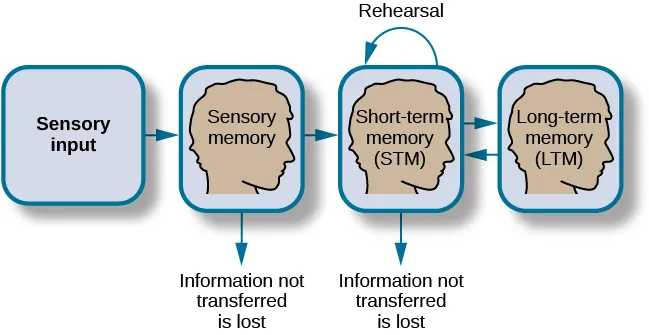
Atkinson and Shiffrin's model (picture)
Based on the belief that we process memories in the same way that a computer processes information
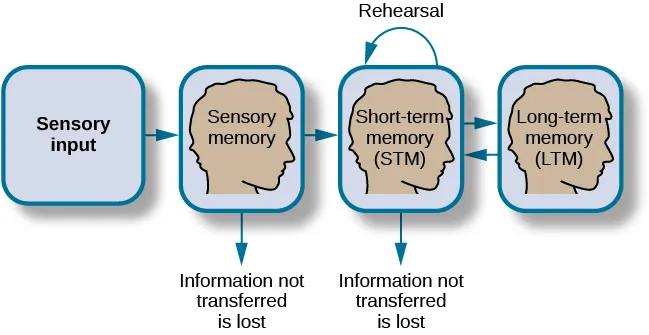
What are the three distinct stages of storage?
Sensory memory
Short-term memory
Long-term memroy
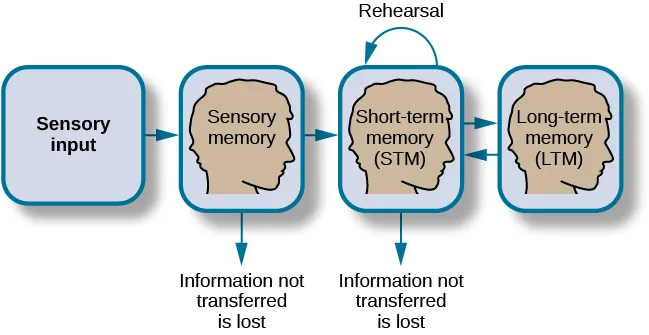
Baddeley and Hitch (1974) proposed a working memory model
Short-term memory has different forms
Storing memories in short-term memory is like opening different files on a computer and adding information
Working memory files hold a limited amount of information
The type of short-term memory (or computer file) depends on the type of information received
There are memories in visual-spatial form, as well as memories of spoken or written material, and they are stored in three short-term systems
A central executive part of memory supervises or controls the flow of information to and from the three short-term systems, and the central executive is responsible for moving information into long-term memory
Three short-term systems from Baddeley and Hitch model
Visuospatial sketchpad
Episodic buffer
Phonological loop
Sensory memory
Storage of brief sensory events, such as sights, sounds, and tastes
Atkinson-Shiffrin model
We cannot absorb all of it, or even most of it
Sensory information about sights, sounds, smells, and even textures, which we do not view as valuable information, we discard
If we view something as valuable, the information will move into our short-term memory system
Short-term memory (STM)
A temporary storage system that processes incoming sensory memory
Short-term and working memory are sometimes used interchangeably, but they are not exactly the same. Why?
Short-term memory is more accurately described as a component of working memory
Short-term memory takes information from sensory memory and sometimes connects that memory to something already in long-term memory
Short-term memory storage lasts 15 to 30 seconds
Rehearsal
Moves information from short-term memory to long-term memory
What are the two types of rehearsal?
Active rehearsal
Elaborative rehearsal
Active rehearsal
A way of attending to information to move it from short-term to long-term memory
You repeat (practice) the information to be remembered
If you repeat it enough, it may be moved into long-term memory
Elaborative rehearsal
Act of linking new information you are trying to learn to existing information that you already know
George Miller (1956)
Reviewed most of the research on the capacity of short-term memory and found that people can retain between 5 and 9 items, so he reported the capacity of short-term memory was the "magic number" 7 plus or minus 2
However, more contemporary research has found working memory capacity is 4 plus or minus 1
Often slightly better for information we hear (acoustic encoding) rather than information we see (visual encoding)
Peterson and Peterson (1959)
Memory trace decay and interference are two factors that affect short-term memory retention
Investigated short-term memory using the three letter sequences called trigrams that had to be recalled after various time intervals between 3 and 18 seconds
During decay, the memory trace becomes less activated over time, and the information is forgotten
Keppel and Underwood (1962)
Examined only the first trials of the trigram task and found that proactive interference also affected short-term memory retention
During proactive interference, previously learned information interferes with the ability to learn new information
Both memory trace decay and proactive interference affect short-term memory
Once the information reaches long-term memory, it has to be consolidated at both the synaptic level, which takes a few hours, and into the memory system, which can take weeks or longer
Long-term memory (LTM)
Continuous storage of information
Storage capacity is believed to be unlimited
Memories are organized in semantic (or associative) networks
Semantic network
Consists of concepts, and as you may recall from what you’ve learned about memory, concepts are categories or groupings of linguistic information, images, ideas, or memories, such as life experiences
Concepts are believed to be arranged hierarchically in the mind
Related concepts are linked, and the strength of the link depends on how often two concepts have been associated
Differ depending on personal experiences
Spreading activation
Important for memory, activating any part of a semantic network also activates the concepts linked to that part to a lesser degree
If one part of a network is activated, it is easier to access the associated concepts because they are already partially activated
When you remember or recall something, you activate a concept, and the related concepts are more easily remembered because they are partially activated
However, the activations do not spread in just one direction
When you remember something, you usually have several routes to get the information you are trying to access, and the more links you have to a concept, the better your chances of remembering
What are the two types of long-term memory?
Explicit
Implicit
Explicit memory
Those we consciously try to remember, recall, and report
Divided into episodic memory and semantic memory
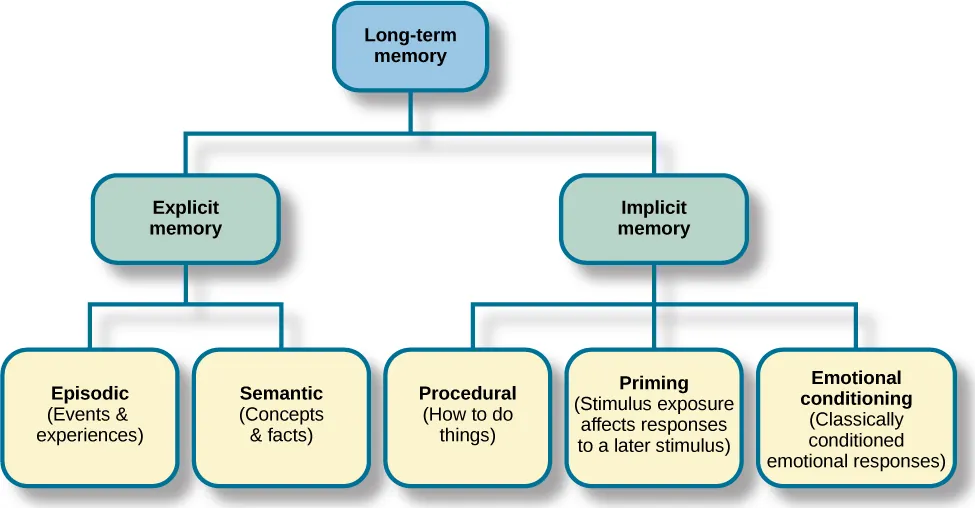
Episodic memory
AKA Autobiographical memories
Information about events we have personally experienced (i.e., an episode)
First proposed about in the 1970s (Tulving, 1972)
Involves recollection of visual imagery as well as the feeling of familiarity
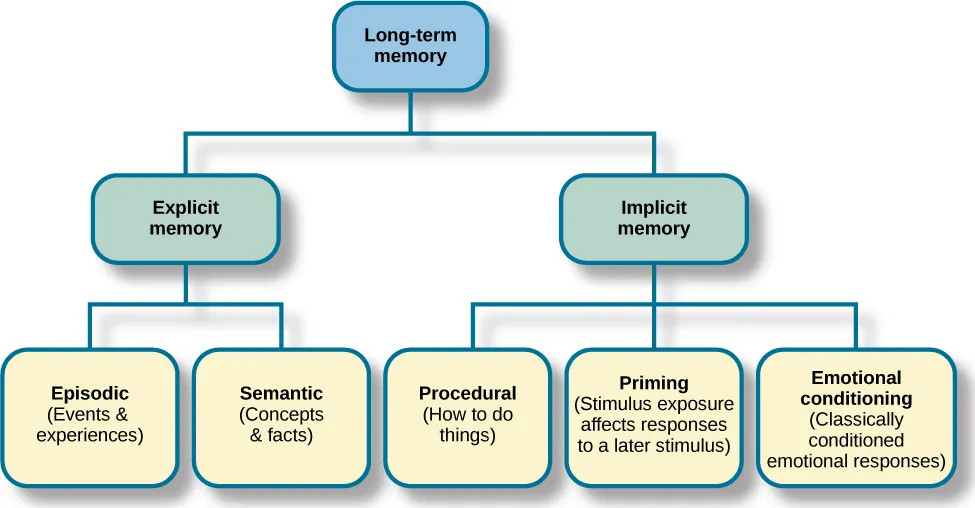
Semantic memory
Knowledge about words, concepts, and language-based knowledge and facts
Typically reported as facts
Having to do with language and knowledge about language
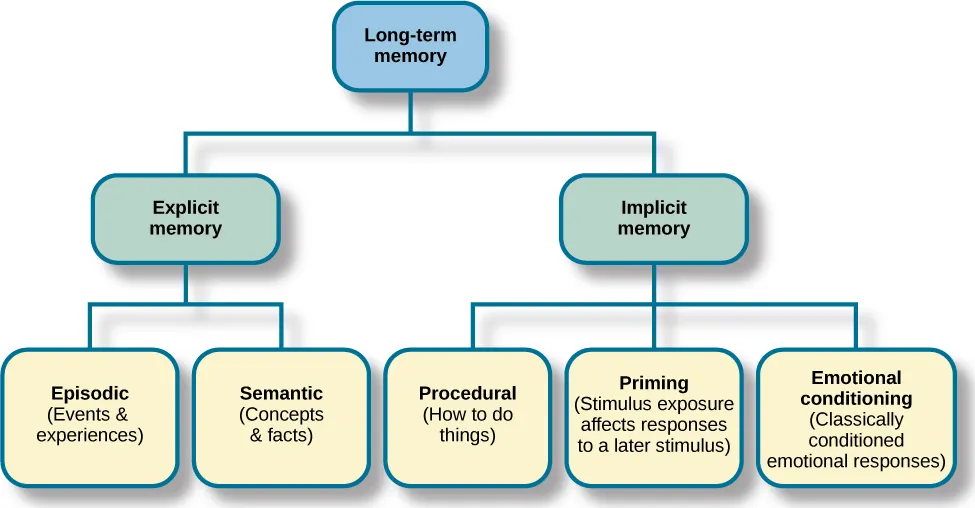
Implicit memories
Long-term memories that are not part of our consciousness
Demonstrated in the performance of some task
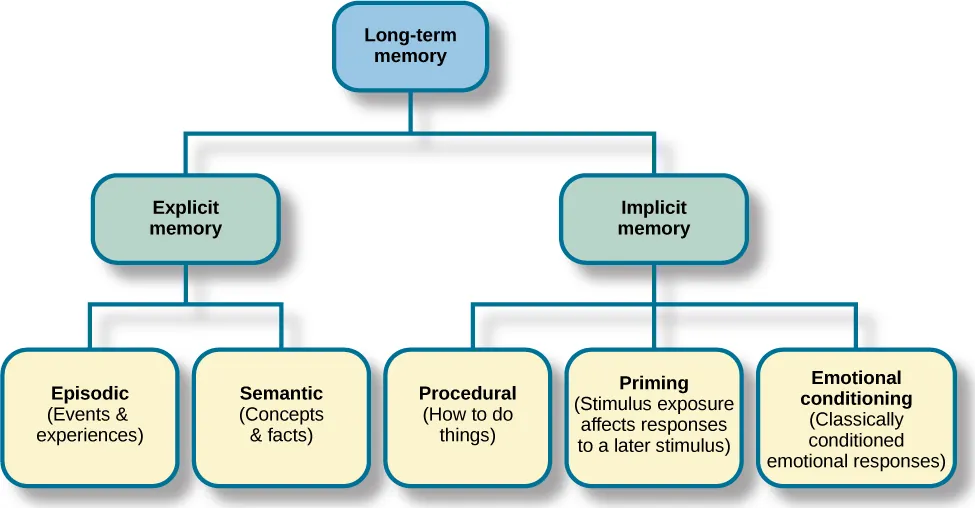
What are the two types of explicit memory?
Episodic
Semantic
What are the three types of implicit memory?
Procedural
Priming
Emotional conditioning
Procedural memory
Often studied using observable behaviors
Stores information about the way to do something, and it is the memory for skilled actions, such as brushing your teeth, riding a bicycle, or driving a car
When you first learned to do these tasks, someone may have told you how to do them, but everything you learned since those instructions that you cannot readily explain to someone else as the way to do it is implicit memory
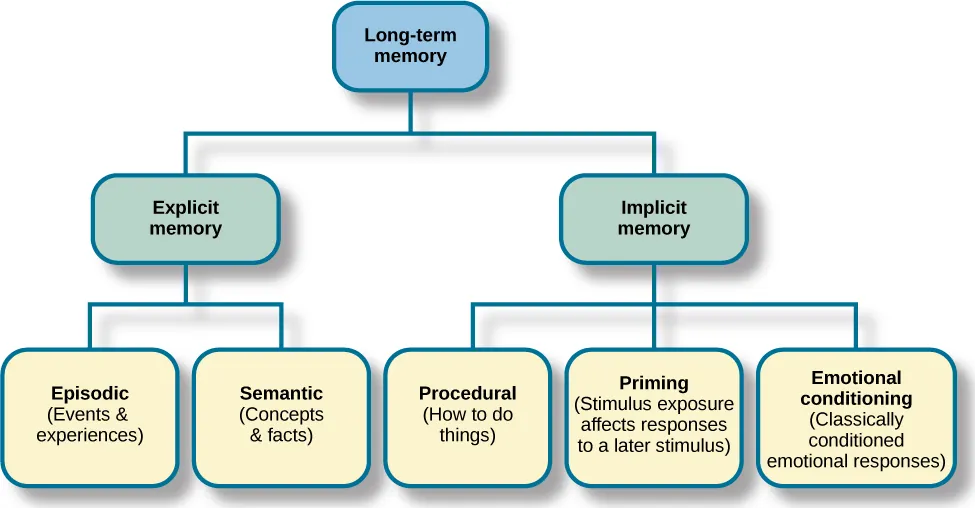
Priming
Type of implicit memory
Exposure to a stimulus affects the response to a later stimulus
Can vary and may include words, pictures, and other stimuli to elicit a response or increase recognition
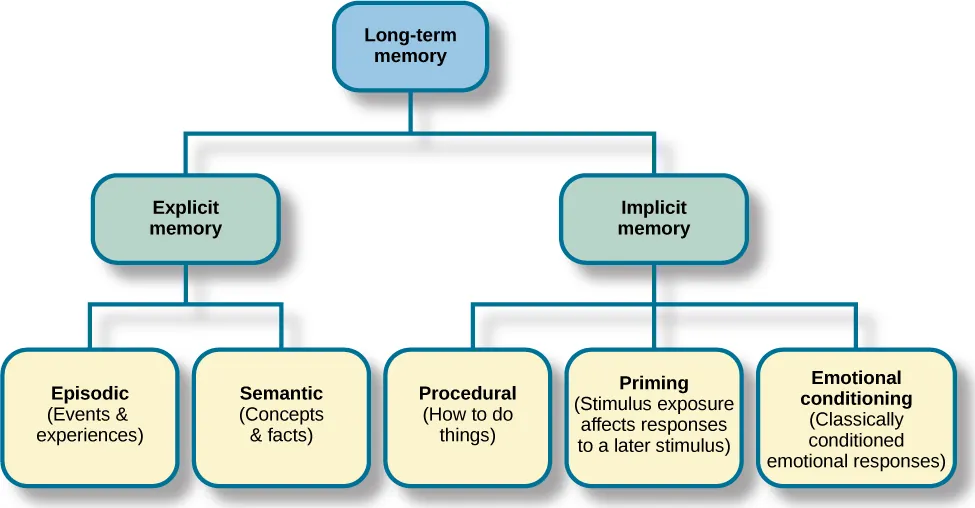
Retrieval
Act of getting information out of memory storage and back into conscious awareness
Recall
What we most often think about when we talk about memory retrieval: it means you can access information without cues.
Recognition
Happens when you identify information that you have previously learned after encountering it again
Involves a process of comparison
What are the three ways you can retrieve information out of your long-term memory storage system?
Recall
Recognition
Relearning
Relearning
Involves learning information that you previously learned
Engram
Group of neurons that serve as the “physical representation of memory”
Karl Lashley
Are memories stored in just one part of the brain, or are they stored in many different parts of the brain?
Made lesions in the brains of animals such as rats and monkeys
Trained rats to find their way through a maze
He used the tools available at the time—in this case a soldering iron—to create lesions in the rats’ brains, specifically in the cerebral cortex
Did not find evidence of the engram, and the rats were still able to find their way through the maze, regardless of the size or location of the lesion
Equipotentiality hypothesis
If part of one area of the brain involved in memory is damaged, another part of the same area can take over that memory function
Amygdala
Fear and fear memories
Memory formation
Regulate emotions
Plays a part in how memories are stored because storage is influenced by stress hormones
Involved in memory consolidation: the process of transferring new learning into long-term memory
Using Pavlovian conditioning, a neutral tone was paired with a foot shock to the rats; produced a fear memory in the rats. After being conditioned, each time they heard the tone, they would freeze (a defense response in rats), indicating a memory for the impending shock
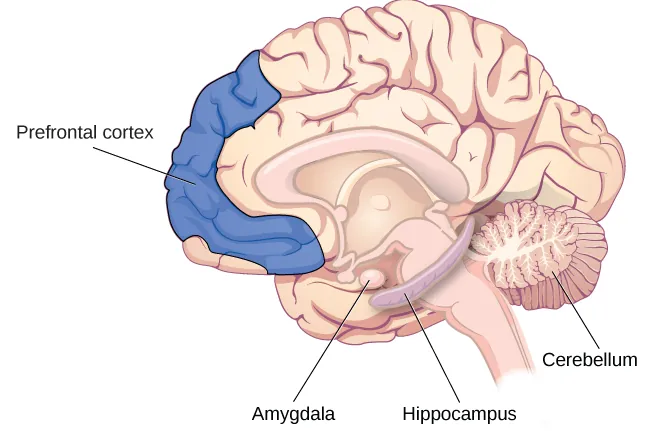
Hippocampus
Associated with declarative and episodic memory as well as recognition memory
Project information to cortical regions that give memories meaning and connect them with other memories
lays a part in memory consolidation: the process of transferring new learning into long-term memory.
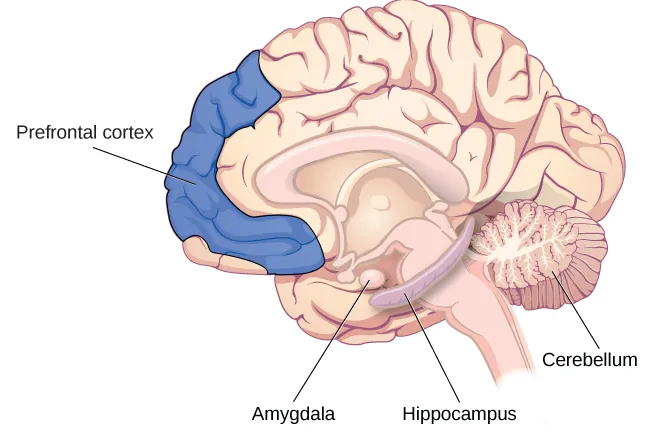
Cerebellum
Plays a role in processing procedural memories, such as how to play the piano
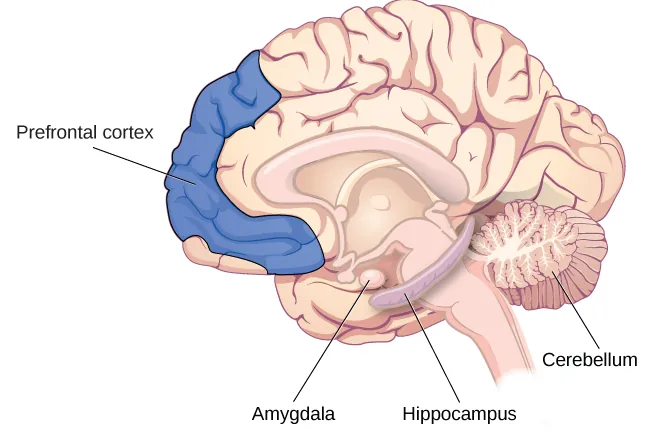
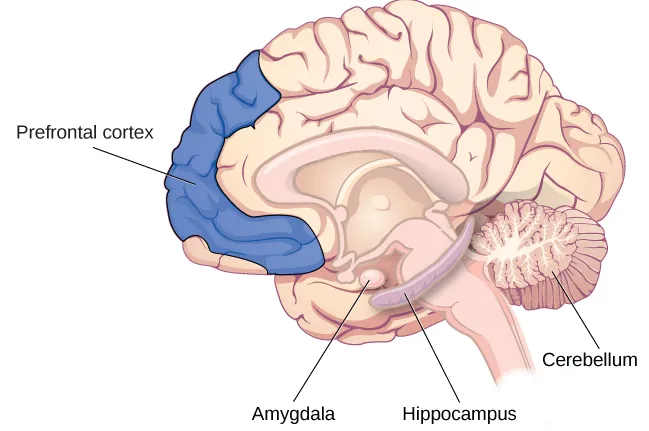
Prefrontal cortex
Appears to be involved in remembering semantic tasks
Arousal theory
Strong emotions trigger the formation of strong memories, and weaker emotional experiences form weaker memories
Flashbulb memory
An exceptionally clear recollection of an important event
Amnesia
Loss of long-term memory that occurs as the result of disease, physical trauma, or psychological trauma
What are the two common types of amnesia?
Anterograde amnesia
Retrograde amnesia
Anterograde amnesia
Commonly caused by brain trauma, such as a blow to the head
You cannot remember new information, although you can remember information and events that happened prior to your injury
Hippocampus is usually affected
Suggests that damage to the brain has resulted in the inability to transfer information from short-term to long-term memory; that is, the inability to consolidate memories

Retrograde amnesia
Loss of memory for events that occurred prior to the trauma
Cannot remember some or even all of their past
Difficulty remembering episodic memories

Construction
Formulation of new memories
Reconstruction
Process of bringing up old memories
Suggestibility
Describes the effects of misinformation from external sources that leads to the creation of false memories
Misinformation effect paradigm
created by cognitive psychologist Elizabeth Loftus
Holds that after exposure to additional and possibly inaccurate information, a person may misremember the original event
The implied information about speed, based on the verb they heard, had an effect on the participants’ memory of the accident
False memory syndrome
Recall of false autobiographical memories
Relates to memories of events that do not have independent witnesses—often the only witnesses to the abuse are the perpetrator and the victim (e.g., sexual abuse)
Forgetting
Loss of information from long-term memory.
Psychologist Daniel Schacter (2001)
Offers seven ways our memories fail us
Calls them the “seven sins of memory”
What are the three categories of seven sins of memory?
forgetting
Distortion
Intrusion
Transience
Forgetting
Accessibility of memory decreases over time
Forget events that occurred long ago
Absentmindedness
Forgetting
Forgetting caused by lapses in attention
Forget where your phone is
Blocking
Forgetting
Accessibility of information is temporarily blocked
Tip of the tongue
Misattribution
Distortion
Source of memory is confused
Recalling a dream memory as a waking memory
Suggestibility
Distortion
False memories
Result from leading questions
Bias
Distortion
Memories distorted by current belief system
Align memories to current beliefs
Persistence
Intrusion
Inability to forget undesirable memories
Traumatic events
German psychologist Hermann Ebbinghaus
Analyzed the process of memorization
Memorized lists of nonsense syllables
Due to storage decay, an average person will lose 50% of the memorized information after 20 minutes and 70% of the information after 24 hours
Your memory for new information decays quickly and then eventually levels out
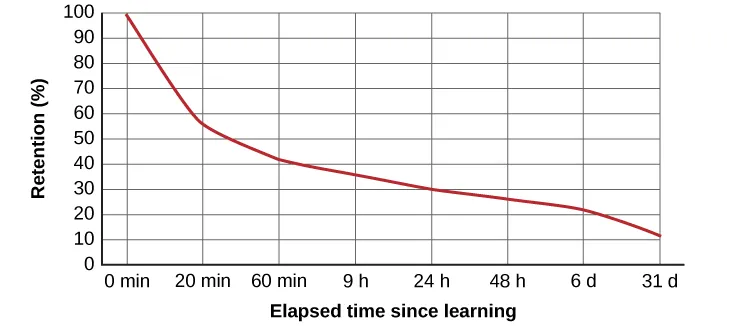
Interference
Sometimes information is stored in our memory, but for some reason it is inaccessible
What are the two types of interference?
Proactive interference
Retroactive interference
Proactive interference
When old information hinders the recall of newly learned information.
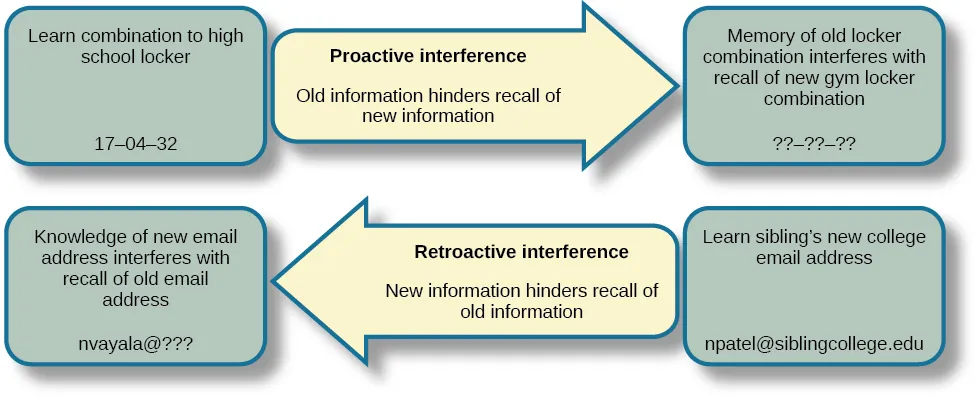
Retroactive interference
Happens when information learned more recently hinders the recall of older information
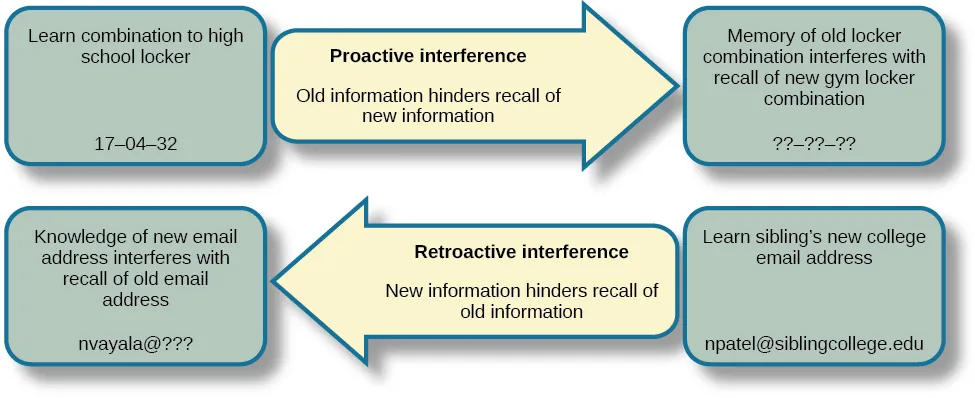
Memory-enhancing strategies
Ways we can improve our memory
Ex: Rehearsal, or the conscious repetition of information to be remembered
Chunking
You organize information into manageable bits or chunks
Elaborative rehearsal
A technique in which you think about the meaning of new information and its relation to knowledge already stored in your memory
Mnemonic devices
Memory aids that help us organize information for encoding
Especially useful when we want to recall larger bits of information such as steps, stages, phases, and parts of a system
Levels of processing
Fergus Craik and Robert Lockhart (1972) article
If we want to remember a piece of information, we should think about it more deeply and link it to other information and memories to make it more meaningful
Self-reference effect
Relate the material to something you have already learned for another class, or think how you can apply the concepts to your own life.
Distributed practice
Study across time in short durations rather than trying to cram it all in at once
Rehearse, rehearse, rehearse
Review the material over time, in spaced and organized study sessions
Study efficiently
Flash cards
Be aware of interference
To reduce the likelihood of interference, study during a quiet time without interruptions or distractions (like television or music)
Keep moving
Exercise is good for your body, but did you also know it’s also good for your mind?
Aerobic exercise promotes neurogenesis: the growth of new brain cells in the hippocampus, an area of the brain known to play a role in memory and learning
Get enough sleep
While you are sleeping, your brain is still at work
During sleep the brain organizes and consolidates information to be stored in long-term memory
________ is a memory store with a phonological loop, visuospatial sketchpad, episodic buffer, and a central executive.
sensory memory
episodic memory
working memory
implicit memory
working memory
The storage capacity of long-term memory is ________.
one or two bits of information
seven bits, plus or minus two
limited
essentially limitless
Essentially limitless
The three functions of memory are ________.
automatic processing, effortful processing, and storage
encoding, processing, and storage
automatic processing, effortful processing, and retrieval
encoding, storage, and retrieval
encoding, storage, and retrieval
This physical trace of memory is known as the ________.
engram
Lashley effect
Deese-Roediger-McDermott Paradigm
flashbulb memory effect
Lashley effect
An exceptionally clear recollection of an important event is a (an) ________.
engram
arousal theory
flashbulb memory
equipotentiality hypothesis
flashbulb memory
________ is when our recollections of the past are done in a self-enhancing manner.
stereotypical bias
egocentric bias
hindsight bias
enhancement bias
egocentric bias
Tip-of-the-tongue phenomenon is also known as ________.
persistence
misattribution
transience
blocking
blocking
The formulation of new memories is sometimes called ________, and the process of bringing up old memories is called ________.
construction; reconstruction
reconstruction; construction
production; reproduction
reproduction; production
construction; reconstruction
When you are learning how to play the piano, the statement “Every good boy does fine” can help you remember the notes E, G, B, D, and F for the lines of the treble clef. This is an example of a (an) ________.
jingle
acronym
acrostic
acoustic
acrostic
According to a study by Yogo and Fujihara (2008), if you want to improve your short-term memory, you should spend time writing about ________.
your best possible future self
a traumatic life experience
a trivial topic
your grocery list
a traumatic life experience
The self-referencing effect refers to ________.
making the material you are trying to memorize personally meaningful to you
making a phrase of all the first letters of the words you are trying to memorize
making a word formed by the first letter of each of the words you are trying to memorize
saying words you want to remember out loud to yourself
making the material you are trying to memorize personally meaningful to you
Memory aids that help organize information for encoding are ________.
mnemonic devices
memory-enhancing strategies
elaborative rehearsal
effortful processing
mnemonic devices